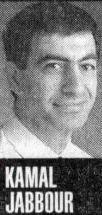

Boston Marathon
Rodgers and Jennings Add Some Intrigue
Published April 19, 1999 in The Post-Standard.By Dr Kamal Jabbour, Contributing Writer
On the third Monday in April, New England celebrates Patriot's Day and the running of the Boston Marathon. At 103 years old, Boston is the oldest and most venerated marathon, and the only marathon to require qualifying entry standards.
Besides the usual celebration of running, this year's Boston Marathon features the long-anticipated showdown between Boston's Bill Rodgers and Syracuse's Ed Stabler. The open winner of four Boston Marathons in the late 1970s, Rodgers returns at age 51 to attempt to set a 50-59 course record.
In reality, Ed Stabler will not be running Boston this year. Stabler won the 50-59 age group in Boston in 1980 and '81 and set an age-group course record of 2 hours, 33 minutes, 1 second. Although Stabler's course record fell to Norm Green in 1983 (2:31:34), it remained the second-fastest Boston Marathon by an over 50-year-old American.
Rodgers also is eyeing Poland's Richard Marczak's 50-59 age-group course record of 2:27:17 and the U.S. point-to-point 50-59 marathon best of 2:25:46. All indications point to a favorable race for Rodgers, who is favored to break all three records.
With four open victories at the New York City Marathon and a Boston Marathon-best of 2:09:27 in 1979, Rodgers continued to race when many of his contemporaries retired. Instead of resting on his trophies as he entered new age groups, he focused on rewriting the master's record books. If Rodgers' training is any predictor, today's Boston Marathon will be no different.
The countdown to Boston brought Rodgers' training back into the vicinity of one hundred miles per week, including several double workout days. Slow days featured an easy 10-miler in the morning and a tempo run in the evening, alternating with interval workouts and hill repeats. A long run of 20 miles at a sub-seven minute pace rounded out a typical week.
Rodgers is not the only American celebrity running the Boston Marathon. At age 38, Lynn Jennings attempts her first serious marathon since her impulsive 2:46 Boston Marathon in 1978. Her undeclared goals include Joan Benoit's U.S. course record of 2:22:43 (set in 1983), Uta Pippig's open course record of 2:21:45 in 1994 and, possibly, Benoit's U.S. open record of 2:21:21 and the one million dollars New Balance bonus.
Jennings is best known as a nine-time U.S. cross country champion, a three-time world cross country champion and the 1992 Olympic bronze medalist in the 10,000 meters in a U.S. record time of 31:19.89. Jennings' Barcelona medal was the first Olympic medal by an American in a distance track event since Billy Mills' 10,000 meters gold medal in the 1964 Tokyo Olympics.
John Babington, currently the head coach at Wellesley College, has coached Jennings since she was 14 years old. Jennings' rebellious first Boston Marathon at age 17 strained the athlete-coach trust and led to a 10-year breakup. A lackluster college career and a sixth-place finish in the 1988 Seoul Olympics led Jennings back to Babington, a 13-time veteran of the Boston Marathon.
From her home in New Market, N.H., Jennings consulted with Babington daily on the phone. Babington was in charge of setting the workouts on hard days, while Jennings retained control onr easy days. Overly sensitive to zeroes in her training log, Jennings tried to run every day. While Rodgers' chances to set age group records at Boston may seem certain, Jennings' untapped marathon potential creates certain excitement and mystery unseen in American running in recent years.
Kamal Jabbour runs and writes on the hills of Pompey, New York. His RUNNING Column appears in The Post-Standard on Mondays. He maintains The Syracuse Running Page and receives email at jabbour@syr.edu.
